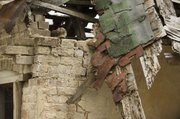FAYETTEVILLE -- A little piece of the mid-19th century at the western edge of the city could come to life within a few years.
The Woolsey farmstead, a home built in 1842 near Farmington on what is now Broyles Avenue, has sat in shambles for decades. The city and a dedicated committee have made it a mission to reconstruct the house and its related structures just south of the Woolsey Wet Prairie Sanctuary and West Side Wastewater Treatment Plant.
CORRECTION
This story has been updated to correct that time element of when Arkansas joined the union.
Preliminary phases
The order and implementation of phases of the project will depend on funding. The Woolsey Farmstead Visionary Committee will discuss the budget at its next meeting.
• Phase I: Stabilization and demolition
• Phase II: Exterior reconstruction
• Phase III: Interior reconstruction
• Phase IV: Smokehouse, potato house, well and cemetery restoration and reconstruction
• Phase V: Outbuildings reconstruction
• Phase VI: Landscape restoration and reconstruction
• Phase VII: Education center and pavilion
Source: Allison+Partners
The home predates Arkansas' entry to the Civil War by three decades and follows the when the state joined the union by six years. Samuel and Matilda Woolsey moved to the area from Randolph County, Ill., in the 1830s, representing some of the earliest settlers of European descent in Washington County. The federal government likely granted the land to the Woolseys in exchange for Samuel Woolsey's time served during the War of 1812.
The Woolseys are buried in a cemetery just behind the house. Several stones mark graves likely belonging to at least some of the 13 Woolsey children. A small smokehouse still stands in front of the home with a collapsed sweet potato house adjoined to it. A rudimentary barn sits in between the main house and the cemetery. A hand-dug well remains at the property.
An ice house, corn crib, chicken house, outhouse, garden and fences likely completed the farmstead but no longer exist.
The City Council in 2014 budgeted $280,000 over five years to clean the farmstead, stabilize the foundation on the house and protect it from deterioration.
Since then, the interior has been shored, a roof membrane put in place, the windows and doors secured and boarded and a wrap placed on the exterior wood to protect it from the elements. There's still a lot more work to do, said Wade Abernathy, the city's division manager of facilities and building construction.
The city spent about $70,000 to get the site where it is now. Another $120,000 got more stabilization and maintenance complete and a plan and site survey in development. The reconstruction project is in the programming, phasing and design stage. The money spent so far doesn't even touch the work needed to bring the farmstead back to modern day.
"Right now, we're trying to see what we have, what we can do with it and then what it's going to cost," Abernathy said.
Architecture firm Allison+Partners tirelessly researched to put together a historical structures report in 2016. A plan was unveiled in February, which lays out the phases and the work required.
The idea is to give visitors a sense of what life was like on the frontier, a time when settlers had to be truly self-sufficient, said Aaron Ruby, lead architect on the project.
"What we're trying to do is tell a story of what the Woolseys encountered and experienced in the early 19th century when they settled the area," he said.
The extent to which the story will be told is up to the visionary committee and ultimately the City Council. The committee met Thursday to go over the phases of the plan. The group hopes to host historical tours and education programs at the site.
The key to reconstruction is in the details. Although some of the bricks and wood remain, new material will have to resemble the original.
"We're not going to go to Home Depot and buy that kind of brick," Ruby said at the meeting.
Paula Marinoni, who helped preserve the homestead in 1999, said extreme care should be taken in reconstructing the home, such as using a timber frame and as many of the original material as possible.
"If we do something we need it to be authentic," she said.
Much of what stands at the house will be removed. The home saw several additions over the years and the committee wants to restore it to its original shape.
The demolition alone will be a painstaking process -- no backhoes, chainsaws or sledgehammers. Big shovels are iffy, Ruby said.
Ruby said money will determine how long the reconstruction effort will take.
The project presents a rare opportunity, not only as a way to learn about early Washington County history but westward expansion in general, Ruby said. Reconstructing the farmstead would bring the potential for visitors to immerse themselves within a physical remnant of the past.
"As we all wonder what the future holds, we really ought to first get a grasp of our past -- only then can we possibly discern a trajectory, good or bad," he said. "Regardless, we have to keep our history if we are to avail ourselves the ability to learn."
NW News on 03/24/2017
